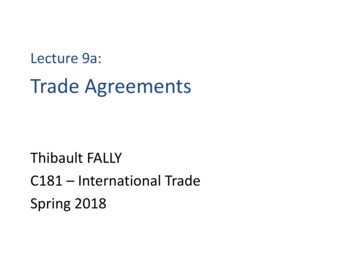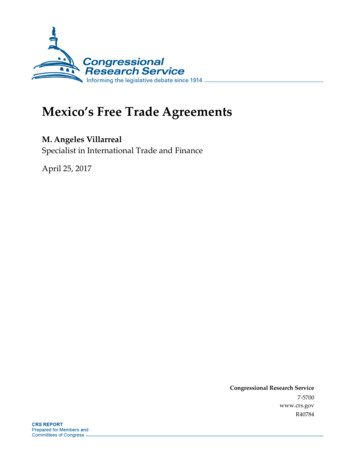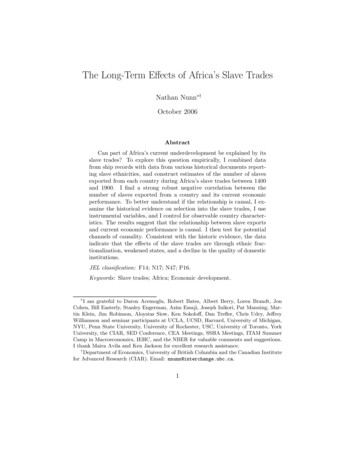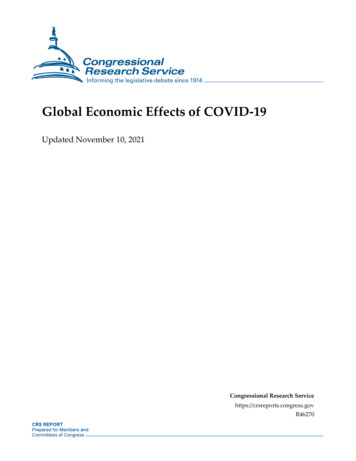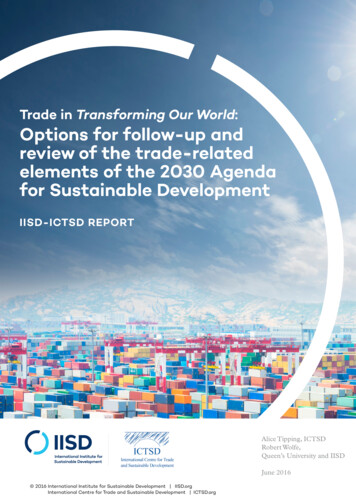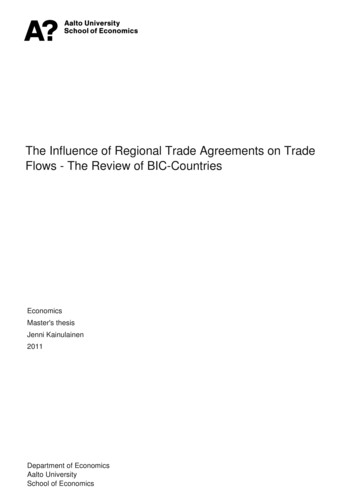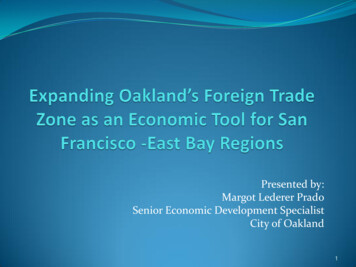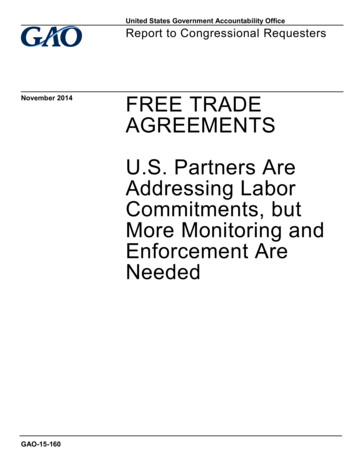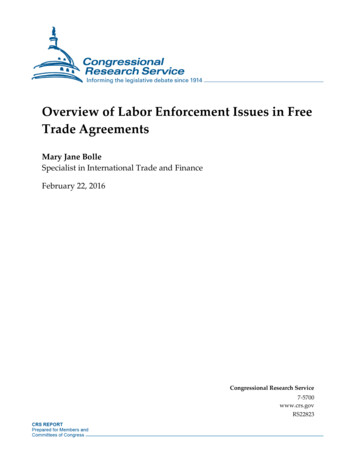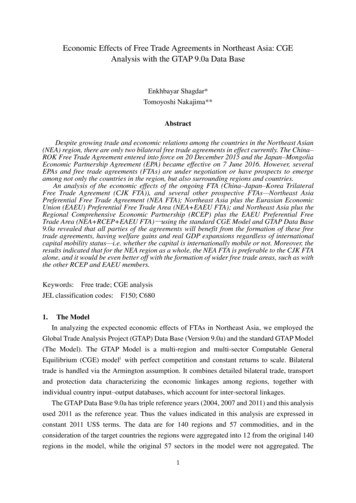
Transcription
Economic Effects of Free Trade Agreements in Northeast Asia: CGEAnalysis with the GTAP 9.0a Data BaseEnkhbayar Shagdar*Tomoyoshi Nakajima**AbstractDespite growing trade and economic relations among the countries in the Northeast Asian(NEA) region, there are only two bilateral free trade agreements in effect currently. The China–ROK Free Trade Agreement entered into force on 20 December 2015 and the Japan–MongoliaEconomic Partnership Agreement (EPA) became effective on 7 June 2016. However, severalEPAs and free trade agreements (FTAs) are under negotiation or have prospects to emergeamong not only the countries in the region, but also surrounding regions and countries.An analysis of the economic effects of the ongoing FTA (China–Japan–Korea TrilateralFree Trade Agreement (CJK FTA)), and several other prospective FTAs—Northeast AsiaPreferential Free Trade Agreement (NEA FTA); Northeast Asia plus the Eurasian EconomicUnion (EAEU) Preferential Free Trade Area (NEA EAEU FTA); and Northeast Asia plus theRegional Comprehensive Economic Partnership (RCEP) plus the EAEU Preferential FreeTrade Area (NEA RCEP EAEU FTA)—using the standard CGE Model and GTAP Data Base9.0a revealed that all parties of the agreements will benefit from the formation of these freetrade agreements, having welfare gains and real GDP expansions regardless of internationalcapital mobility status—i.e. whether the capital is internationally mobile or not. Moreover, theresults indicated that for the NEA region as a whole, the NEA FTA is preferable to the CJK FTAalone, and it would be even better off with the formation of wider free trade areas, such as withthe other RCEP and EAEU members.Keywords: Free trade; CGE analysisJEL classification codes: F150; C6801.The ModelIn analyzing the expected economic effects of FTAs in Northeast Asia, we employed theGlobal Trade Analysis Project (GTAP) Data Base (Version 9.0a) and the standard GTAP Model(The Model). The GTAP Model is a multi-region and multi-sector Computable GeneralEquilibrium (CGE) modeli with perfect competition and constant returns to scale. Bilateraltrade is handled via the Armington assumption. It combines detailed bilateral trade, transportand protection data characterizing the economic linkages among regions, together withindividual country input–output databases, which account for inter-sectoral linkages.The GTAP Data Base 9.0a has triple reference years (2004, 2007 and 2011) and this analysisused 2011 as the reference year. Thus the values indicated in this analysis are expressed inconstant 2011 US terms. The data are for 140 regions and 57 commodities, and in theconsideration of the target countries the regions were aggregated into 12 from the original 140regions in the model, while the original 57 sectors in the model were not aggregated. The1
aggregated regions are: China, Japan, the ROK, Mongolia, Russia, the EAEU4, ASEAN9,ANZI, the Rest of Asia, the United States, the EU 28, and Rest of World. Due to lack of data,the DPRK was not included in the Northeast Asia region, but the country is included implicitlyin the Rest of Asia region as a part of the Rest of East Asia. Thus, the NEA region in thisanalysis refers to five countries in the region, excluding the DPRK (Appendix Tables I and II).The original eight factors in the Model were aggregated into four factors: land, labor, capitaland natural resources, where land and natural resources are immobile and labor and capital aremobile factors (Appendix Table III).The composition of GDP of the countries in question is provided in Table 1. GDP shares offoreign trade activities were the highest for Mongolia among the selected countries with exportsand imports each exceeding 70% of the country’s GDP.Table 1 Composition of GDP, 30.214.820.5-24.2100Rest of .2100EU 2859.919.022.039.3-40.3100Rest of -28.2100Source:GTAP 9.0a Data Base2. The ExperimentsFour FTA scenarios in the NEA region were considered in the simulations where the advalorem import tariffs and tariff equivalents of bilateral nontariff barriers (NTBs) between thecountries in question were removed on a preferential basis. The scenarios were:i)China–Japan–Korea Trilateral Free Trade Agreement (CJK FTA). The membersare: China, Japan and the ROK (CJK);ii)Northeast Asia Preferential Free Trade Agreement (NEA FTA). The members arethe CJK members plus Mongolia and Russia (NEA);2
iii)Northeast Asia plus the Eurasian Economic Union (EAEU) Free Trade Area(NEA EAEU FTA). The members are CJK, Mongolia, Russia and the other fourmembers of the EAEU (EAEU4). The EAEU4 members are described in theAppendix Table I;iv)Northeast Asia plus RCEP plus the EAEU Preferential Free Trade Area(NEA RCEP EAEU FTA). The members are NEA plus the EAEU4, ASEAN9and ANZI members. The ASEAN9 and ANZI members are described in theAppendix Table I.Source-specific change in tax on imports of commodity “i” from country “r” into country“s” is expressed by a variable “tms (i,r,s)” in the Model and shocks were applied for a targetrate of zero for this variable. Both values of the parameter “RORDELTA”, which is theinvestment allocation binary coefficient in the Model, were applied in each scenario to observethe impacts of investment allocation decisions in the assumed FTAs. The default value of theparameter RORDELTA in the Model equals 1, where investment is allocated across regions toequate the change in the expected rates of return, rore (r) which implies international capitalmobility. When RORDELTA equals 0, investments are allocated across regions to maintain theexisting composition of capital stock (no international capital mobility) and it effectively fixesthe trade balance for each country/region. Description of the experiments is provided in Box 1.The solution method was Gragg, or a multiple step extrapolation method.In order to simplify the application of shocks to the Model, three additional subsets of theregions were created by modifying the CMFSTART file of the GTAP Model. These are: CJK,NEA4 (China, Japan, the ROK, and Mongolia) and RCEP (China, Japan, the ROK, ASEAN9and ANZI) and the modified CMFSTART file is illustrated in Box 2, where rows numberedfrom 7 to 15 were added into the default version of the CMFSTART file. The CMFSTART filecontains some additional instructions, which are sent to GEMPACK prior to solving the model.3
Box 1Description of the Experimentsa. China–Japan–KoreaTrilateral Free TradeAgreement (CJK FTA)Shocktms(TRAD COMM,CJK,CJK) target % 0 from file tms.shk;Experiments:Complete removal of advalorem import tariffsand tariff equivalents ofbilateral nontariffbarriers (NTBs)(tms 0%)Export interventionswere not altered.b. Northeast AsiaPreferential Free TradeArea (NEA FTA)(Shocks list is in Box 3)c. Northeast Asia plusEurasian Economic UnionFree Trade Area(NEA EAEU FTA)(Shocks list is in Box 4)d. Northeast Asia plusRCEP plus EuroasianEconomic UnionPreferential Free TradeArea(NEA RCEP EAEU FTA)(Shocks list is in Box 5)Box 2Experiment 1:Default(RORDELTA 1)Experiment 2:(RORDELTA 0)Experiment 3:Default(RORDELTA 1)Experiment 4:(RORDELTA 0)Experiment 5:Default(RORDELTA 1)Experiment 6:(RORDELTA 0)Experiment 7:Default(RORDELTA 1)Experiment 8:(RORDELTA 0)The Modified CMFSTART file1. ! If a version has no CMFSTART file of its own2. ! RunGTAP creates one by copying the supplied file CMFSTART.DEF3. CPU yes; ! log show simulation times4. NDS yes; ! no displays5. Extrapolation accuracy file NO ; ! No XAC file6. !servants 1; ! use 2 processors at once, if possible7. XSET NEA4 #NEA4 regions#8. (China, Japan, ROK, Mongolia);9. XSUBSET NEA4 is subset of REG;10. XSET CJK #ChinaJapanKorea#11. (China, Japan, ROK);12. XSUBSET CJK is subset of NEA4;13. XSET RCEP #RCEP regions#14. (China, Japan, ROK, ASEAN9, ANZI);15. XSUBSET RCEP is subset of REG;Source:GTAP Model4
Box 3Shock Statements in NEA FTA ScenarioShock tms(TRAD COMM,NEA4,NEA4) target % 0 from file tms.shk;Shock tms(TRAD COMM,NEA4,"Russia") target % 0 from file tms.shk;Shock tms(TRAD COMM,"Russia",NEA4) target % 0 from file tms.shk;Source:GTAP ModelBox 4Shock Statements in NEA EAEU FTA ScenarioShock tms(TRAD COMM,NEA4,NEA4) target % 0 from file tms.shk;Shock tms(TRAD COMM,NEA4,"Russia") target % 0 from file tms.shk;Shock tms(TRAD COMM,"Russia",NEA4) target % 0 from file tms.shk;Shock tms(TRAD COMM,"Russia","EAEU") target % 0 from file tms.shk;Shock tms(TRAD COMM,"EAEU","Russia") target % 0 from file tms.shk;Shock tms(TRAD COMM,"EAEU",NEA4) target % 0 from file tms.shk;Shock tms(TRAD COMM,NEA4,"EAEU") target % 0 from file tms.shk;Source: GTAP Model.Box 5Shock Statements in NEA RCEP EAEU FTA ScenarioShock tms(TRAD COMM,RCEP,RCEP) target % 0 from file tms.shk;Shock tms(TRAD COMM,RCEP,"EAEU") target % 0 from file tms.shk;Shock tms(TRAD COMM,"EAEU",RCEP) target % 0 from file tms.shk;Shock tms(TRAD COMM,"EAEU","EAEU") target % 0 from file tms.shk;Shock tms(TRAD COMM,RCEP,"Mongolia") target % 0 from file tms.shk;Shock tms(TRAD COMM,RCEP,"Russia") target % 0 from file tms.shk;Shock tms(TRAD COMM,"Mongolia",RCEP) target % 0 from file tms.shk;Shock tms(TRAD COMM,"Russia",RCEP) target % 0 from file tms.shk;Shock tms(TRAD COMM,"Russia","EAEU") target % 0 from file tms.shk;Shock tms(TRAD COMM,"Mongolia","EAEU") target % 0 from file tms.shk;Shock tms(TRAD COMM,"Mongolia","Russia") target % 0 from file tms.shk;Shock tms(TRAD COMM,"Russia","Mongolia") target % 0 from file tms.shk;Shock tms(TRAD COMM,"EAEU","Russia") target % 0 from file tms.shk;Shock tms(TRAD COMM,"EAEU","Mongolia") target % 0 from file tms.shk;Source: GTAP Model.5
3.The Resultsa) China–Japan–Korea Trilateral Free Trade Agreement (CJK FTA)In terms of the equivalent variation (EV), which is an indicator for measuring the effect onpublic welfare, the simulation results demonstrated that all three countries, China, Japan andthe ROK, would benefit from the CJK FTA regardless of the investment allocation decisions,while other countries and regions, including those in the NEA region, would experience welfarelosses and real GDP contractions.In Experiment 1, with international capital mobility, Japan would have the largest welfaregain of US 21.4 billion, while those for the ROK and China equaled US 11.2 billion andUS 1.9 billion, respectively. Most of Japan’s welfare gain was associated with gains in termsof trade in goods and services equaling US 15.2 billion, while the ROK had relatively equalgains in terms of allocative efficiency (US 5.6 billion) and terms of trade in goods and services(US 5.8 billion). However, the ROK may experience a slight loss in its terms of trade ininvestment and savings equaling US 237 million. At the same time, China’s allocativeefficiency and terms of trade in investment and savings were improved by US 4.46 billion andUS 475 million, respectively, while the country’s terms of trade in goods and services wouldworsen by US 3.05 billion. However, the net effect was positive, equaling US 1.88 billion, asthe allocative efficiency and terms of trade in investment and savings gains were larger than theterms of trade losses in goods and services. Although Russia was not a part of the CJK FTA,the country may benefit by having a welfare gain of US 43 million, when the capital is notmobile across regions (Table 2).In addition, the simulation results indicated that the CJK FTA would result in positivechanges in all the three countries’ real GDP (expressed in the GDP quantity index) regardlessof the investment allocation decisions. The ROK’s real GDP change was the highest, equaling0.467% and 0.356% depending on the investment allocation decisions, while those for Japanwere 0.1% and 0.096%, and for China 0.061% and 0.054%. Higher values were observed whencapital is internationally mobile (Table 3).b) Northeast Asia Preferential Free Trade Area (NEA FTA)As expected, all members of the NEA region had welfare gains in the case of the NEA FTA,regardless of investment allocation decisions, while other regions would experience welfarelosses and real GDP contractions. Welfare gains for Japan were the highest among the FTAmembers, equaling US 23.5 billion, followed by the ROK’s US 12.4 billion and China’sUS 5.1 billion, when capital is internationally mobile. The other members of this FTA, Russiaand Mongolia, had welfare gains of US 1.97 billion and US 58 million, respectively. Thesevalues were lower when capital is internationally immobile (Table 2).When capital is internationally mobile (Experiment 3), most of the welfare gains wereassociated with allocative efficiency gains as well as improvements in terms of trade in goods6
and services for all NEA countries, except Russia. Russia would have a loss of US 785 millionin its terms of trade in goods and services, but due to its gains of US 1.5 billion in its terms oftrade in investment and savings and US 1.2 billion gains in allocative efficiency, the country’stotal welfare gain from this FTA was positive, equaling US 1.92 billion (Appendix Table V).Moreover, all members of the NEA FTA would expect positive changes in their real GDPregardless of investment allocation decisions. The gains were higher when capital isinternationally mobile. The ROK would benefit most from the formation of the NEA FTA, withits real GDP increasing by 0.482% when capital is internationally mobile and 0.363% whencapital is internationally immobile. In addition, the foreign trade activities of all NEA countrieswould increase as a result of this agreement and the increase for merchandize exports rangedbetween 1.12% (the lowest) for Japan and 4.374% (the highest) for the ROK, depending oninternational capital mobility, while the increase for merchandize imports would range between1.049% (the lowest) for Mongolia and 5.274% (the highest) for the ROK. However, Mongolia’smerchandise exports would decline by 0.401% when international capital is mobile (Tables 3,5 and 6).In terms of nominal GDP (expressed in the value of GDP), Russia may be affectednegatively in both the cases of international capital mobility due to drops in its aggregate prices.Russia’s GDP price index dropped respectively by 0.883% and 1.145%, when capital isinternationally mobile and immobile. In addition, the prices of Russia’s merchandise exportsdeclined in both cases and the price index of its merchandise exports were 0.264% and 0.347%lower, respectively, when capital is internationally mobile and immobile. Mongolia would alsoexperience a drop in its nominal GDP of 0.313% without international capital mobility, due tothe 0.334% reduction in its aggregate prices (Table 4 and Appendix Tables VII and VIII).c) Northeast Asia plus the Eurasian Economic Union (EAEU) Preferential FreeTrade Area (NEA EAEU FTA)All countries in the NEA region would benefit from the formation of this FTA regardlessof investment allocation decisions, while other countries and regions would experience welfarelosses and real GDP contractions. The magnitude of these benefits were larger for all the NEAcountries, except Russia, in the NEA EAEU FTA scenario compared to the previous two FTAscenarios. The welfare gains ranged between US 61 million for Mongolia and US 23.5 billionfor Japan, while Russia’s welfare gain became slightly lower than the NEA FTA scenario,equaling US 1.958 billion when capital is internationally mobile. At the same time, real GDPexpansion ranged between 0.062% (the lowest) for Russia and 0.484% (the highest) for theROK when capital is internationally mobile. The gains were lower without international capitalmobility and welfare gains ranged between US 21 million (the lowest) for Mongolia andUS 20.4 billion (the highest) for Japan, while real GDP changes were 0.029% (the lowest) forMongolia and 0.364% (the highest) for the ROK. Changes in nominal GDP had a similar pattern7
with the NEA FTA (Tables 3 and 4).However, despite being a part of this FTA, the other four members of the EAEU (EAEU4)may experience welfare losses as a result of the formation of this FTA, along with contractionsof their real and nominal GDP due to losses in their allocation efficiency and worsening of theterms of trade in goods and services. EAEU4‘s terms of trade in goods and services worsenedby US 194 when capital is internationally mobile. Russia’s nominal GDP may also contract by0.85% and 1.12% depending on international investment allocation decisions. This wasassociated with price drops of their merchandize exports. Price decline of merchandize exportsin the EAEU area would range between 0.282% and 0.421% depending on international capitalmobility (Table 3 and Appendix Table VIII).d) Northeast Asia plus RCEP plus the EAEU Preferential Free Trade Area(NEA RCEP EAEU FTA)All countries in the NEA, RCEP and EAEU areas, except the EAEU4, would benefit fromformation of this FTA by having welfare gains and real GDP expansions regardless ofinvestment allocation decisions, while other countries and regions would experience welfarelosses and real GDP contractions. The magnitude of these gains were larger for all the NEAcountries in this scenario than in the previous three FTA scenarios. Welfare gains rangedbetween US 70 million for Mongolia and US 31.8 billion for Japan and real GDP expansionswere between 0.012% (the lowest) for the EAEU4 and 0.534% (the highest) for the ROK, whencapital is internationally mobile. Without international capital mobility, the gains were lowerand the welfare gains ranged between US 19 million for Mongolia and US 28 billion for Japan,while the ROK’s real GDP expansion was also the highest, equaling 0.394%. Similar to theprevious FTA scenario, although being a part of this FTA, the EAEU4 members wouldexperience welfare losses regardless of investment allocation decisions and may see no impactson their real GDP when capital is not internationally mobile (Tables 2 and 3).Impacts on nominal GDP had a similar pattern as in the NEA EAEU FTA scenario.Mongolia’s aggregate level of prices became 1.083% lower when capital is not internationallymobile. Also, Russia, the EAEU4 and the ANZI members may experience reductions in theirnominal GDP in both the cases of international capital mobility decisions due to drops of theiraggregate price indices. At the same time, prices of merchandise exports of these countrieswould decline in a range of 0.098% to 0.439% (Table 4 and Appendix Tables VII, VIII).8
Table 2Equivalent Variations (EVs) via the FTAs(2011 US million)No international capital mobilityInternational capital mobilityNEARegionsCJKNEAFTAFTANEA EAEU RCEP EAEUFTANEACJKNEAFTAFTAFTANEA EAEUFTA RCEP 8-1,2105,142-1,765-2,053-2,1097,904Rest of ,924EU 53Rest of ,840MongoliaRussiaEAEU4Source:GTAP Model, simulation resultsTable 3Real GDP Changes via the FTAs (qgdp GDP quantity index)(% change)No international capital mobilityChina0.0540.0620.0640.101International capital mobilityNEANEACJKNEA RCEP EAEUFTAFTA 0.0160.239Rest of 007EU Rest of 024RegionsMongoliaSource:CJKFTANEAFTANEA EAEUFTANEA RCEP EAEUFTAGTAP Model, simulation results9
Table 4 Changes in Nominal GDP (vgdp change in value of GDP)(% change)No international capital mobilityRegionsCJKFTANEAFTANEA EAEUFTANEA RCEP EAEUFTAInternational capital mobilityCJKFTANEAFTANEA EAEUFTANEA RCEP -0.179Rest of 772EU Rest of 655Source:Table 5GTAP Model, simulation resultsChanges in Real Exports (qxwreg change in volume of merchandise exports)(% change)No international capital mobilityRegionsCJKFTANEAFTANEA EAEUFTANEA RCEP EAEUFTAInternational capital mobilityCJKFTANEAFTANEA EAEUFTANEA RCEP 8-0.1576.0790.1250.1310.1304.920Rest of U 28-0.046-0.091-0.096-0.1750.0700.0780.0790.144Rest of ource:GTAP Model, simulation results10
Table 6Changes in Real Imports (qiwreg change in volume of merchandise imports)(% change)No international capital mobilityRegionsCJKFTANEAFTANEA EAEUFTANEA RCEP EAEUFTAInternational capital mobilityCJKFTANEAFTANEA EAEUFTANEA RCEP 0.121-0.1284.738-0.226-0.282-0.2935.187Rest of 133EU Rest of 503Source:GTAP Model, simulation results4.ConclusionsCGE analysis of the economic impacts of the four prospective free trade agreementscovering the NEA region using GTAP Model and Data Base 9.0a have demonstrated thatremoving tariff barriers will benefit all parties of a free trade agreement, due to increased tradeand economic activities. Specifically, in the cases of:a) CJK Trilateral Free Trade Agreement: All three countries, China, Japan and the ROK,will benefit as a result of this agreement having positive EV values and real GDPexpansions regardless of whether capital is internationally mobile or not. The ROKwould benefit most in terms of real GDP change. All other regions would experiencewelfare losses, including those in the NEA region, except Russia when capital is notinternationally mobile.b) NEA Preferential Free Trade Area: All five countries in the NEA region would benefitfrom formation of an NEA FTA, having welfare gains and increases of real GDPregardless of the investment allocation decisions. The ROK was the largest winner interms of its real GDP expansion. The other countries and regions in the modelexperienced welfare losses and contractions of their real GDP as well.11
c) NEA EAEU Preferential Free Trade Area: All countries in the NEA region wouldbenefit from formation of this FTA regardless of investment allocation decisions, whileother countries and regions would experience welfare losses and real GDP contractions.The magnitude of these benefits were larger for all the NEA countries, except Russia,in this scenario compared to the previous two FTA cases. Japan was the largest winnerin terms of welfare gains, while the ROK would be the top beneficiary in terms of realGDP expansion.However, despite being a part of this FTA, the EAEU4 members may experiencewelfare losses along with drops in their real and nominal GDP due to their allocativeefficiency losses and worsening of terms of trade in goods and services.d) NEA RCEP EAEU Preferential Free Trade Area: Similar to the previous scenario,all countries in the NEA region would benefit from this agreement by having welfaregains and expansions of real GDP regardless of international capital mobility decisions.All countries in the NEA region were better off under this scenario than the previousthree FTA cases, whereas Japan was the largest winner in terms of welfare gains andnominal GDP expansion, while the ROK would benefit most in terms of its real GDPexpansion. The other members of the RCEP region would also benefit from this FTA byexperiencing welfare gains and real GDP expansions. However, in both cases ofinternational capital mobility, Russia, the EAEU4 and ANZI would experiencereductions in terms of nominal GDP due to drops in their aggregate price indices.Accordingly, for the NEA region as a whole, the NEA FTA is preferable to CJK FTA only,and would be even better off in formation of a wider coverage of free trade agreement partners,such as RCEP and the EAEU, where all the countries in the region would benefit from largerwelfare gains and real GDP expansions regardless of the investment allocation decisions.*Senior Research Fellow, Research Division, ERINA** Senior Research Fellow, Research Division, ERINAiFor more details on the GTAP model and database, refer to Hertel, T. (ed.), 1997.12
ReferencesADAMS, Philip D. (2003). Interpretation of Macroeconomic Results from a CGE Model suchas GTAP, Centre of Policy Studies, Monash University. Available online.BEGG, M., Ch. BURMAA, et al (2012). “GTAP 8 Data Base Documentation - Chapter 7.C:Mongolia” by BEGG, Michael, BURMAA Chadraaval, RAGCHAARSUREN Galindev,ESMEDEKH Lkhanaajav, and ERDENESAN Eldev-Ochir. Retrieved from:https://www.gtap.agecon.purdue.eduENKHBAYAR Shagdar and Tomoyoshi NAKAJIMA (2013). Impacts of Mongolian FTAs withthe Countries in Northeast Asia: CGE Analysis with the GTAP 8 Data Base. The NortheastAsian Economic Review, Vol. 1, No. 2, December 2013, pp. 43–67.ENKHBAYAR Shagdar and OTGONSAIKHAN Nyamdaa (2017). Impacts of Import TariffReforms on Mongolia’s Economy: CGE Analysis with the GTAP 8.1 Data Base, TheNortheast Asian Economic Review, Vol. 5, No. 1, March 2017, pp. 1–25HERTEL, T. (ed.) (1997). Global Trade Analysis: Modeling and Applications. CambridgeUniversity PressNAKAJIMA, Tomoyoshi (2012). “The ROK’s FTA Policy: Developments under the Lee Myungbak Administration”, The Journal of Econometric Study of Northeast Asia, Vol. 8, No. 2,2012NARAYANAN, G. Badri, Angel AGUIAR, and Robert McDOUGALL (eds.) (2012). GlobalTrade, Assistance, and Production: The GTAP 8 Data Base, Center for Global TradeAnalysis, Purdue University13
Appendix Table I:Classification of Regions in the ModelThe ModelGTAP 9.0a (140 regions)(12 regions)ChinaChinaJapanJapanROKRepublic of KoreaMongoliaMongoliaRussiaRussian FederationEAEU4Kazakhstan, Kyrgyzstan, Armenia, BelarusASEAN9ASEAN9 members, except Myanmar: Brunei Darussalam, Cambodia, Indonesia,Lao People's Democratic Republic, Malaysia, Philippines, Singapore, Thailand,VietnamANZIAustralia, New Zealand, IndiaRest of AsiaHong Kong, Taiwan, Rest of East Asia, Rest of Southeast Asia, Bangladesh, Nepal,Pakistan, Sri Lanka, Rest of South AsiaUSAUnited States of AmericaEU 28Austria, Belgium, Cyprus, Czech Republic, Denmark, Estonia, Finland, France,Germany, Greece, Hungary, Ireland, Italy, Latvia, Lithuania, Luxembourg, Malta,Netherlands, Poland, Portugal, Slovakia, Slovenia, Spain, Sweden, UnitedKingdom, Bulgaria, Romania, CroatiaRest of WorldRest of Oceania, Canada, Mexico, Rest of North America, Argentina, Bolivia,Brazil, Chile, Colombia, Ecuador, Paraguay, Peru, Uruguay, Venezuela, Rest ofSouth America, Costa Rica, Guatemala, Honduras, Nicaragua, Panama,El Salvador, Rest of Central America, Dominican Republic, Jamaica, Puerto Rico,Trinidad and Tobago, Caribbean, Switzerland, Norway, Rest of EFTA, Albania,Ukraine, Rest of Eastern Europe, Rest of Europe, Rest of Former Soviet Union,Azerbaijan, Georgia, Bahrain, Islamic Republic of Iran, Israel, Jordan, Kuwait,Oman, Qatar, Saudi Arabia, Turkey, United Arab Emirates, Rest of Western Asia,Egypt, Morocco, Tunisia, Rest of North Africa, Benin, Burkina Faso, Cameroon,Côte d'Ivoire, Ghana, Guinea, Nigeria, Senegal, Togo, Rest of Western Africa,Central Africa, South Central Africa, Ethiopia, Kenya, Madagascar, Malawi,Mauritius, Mozambique, Rwanda, Tanzania, Uganda, Zambia, Zimbabwe, Rest ofEastern Africa, Botswana, Namibia, South Africa, Rest of South African Customs,Rest of the WorldSource:GTAP 9.0a Data Base14
Appendix Table 7282930313233343536373839Codepdrwhtgrov fosdc crsgrofdb ttexwaplealumpppp ccrpnmmi snfmfmpmvhotnClassification of Sectors in the ModelDescriptionPaddy riceWheatCereal grains nec.Vegetables, fruit,
Economic Effects of Free Trade Agreements in Northeast Asia: CGE Analysis with the GTAP 9.0a Data Base Enkhbayar Shagdar* Tomoyoshi Nakajima** Abstract Despite growing trade and economic relations among the countries in the Northeast Asian (NEA) region, there are only two bilateral free trade

